The NVIDIA GeForce RTX 2060 6GB Founders Edition Review: Not Quite Mainstream
by Nate Oh on January 7, 2019 9:00 AM ESTBattlefield 1 (DX11)
Battlefield 1 returns from the 2017 benchmark suite, the 2017 benchmark suite with a bang as DICE brought gamers the long-awaited AAA World War 1 shooter a little over a year ago. With detailed maps, environmental effects, and pacy combat, Battlefield 1 provides a generally well-optimized yet demanding graphics workload. The next Battlefield game from DICE, Battlefield V, completes the nostalgia circuit with a return to World War 2, but more importantly for us, is one of the flagship titles for GeForce RTX real time ray tracing, although at this time its realtime raytracing isn't ready to be used as a generalizable benchmark.
We use the Ultra preset is used with no alterations. As these benchmarks are from single player mode, our rule of thumb with multiplayer performance still applies: multiplayer framerates generally dip to half our single player framerates. Battlefield 1 also supports HDR (HDR10, Dolby Vision).
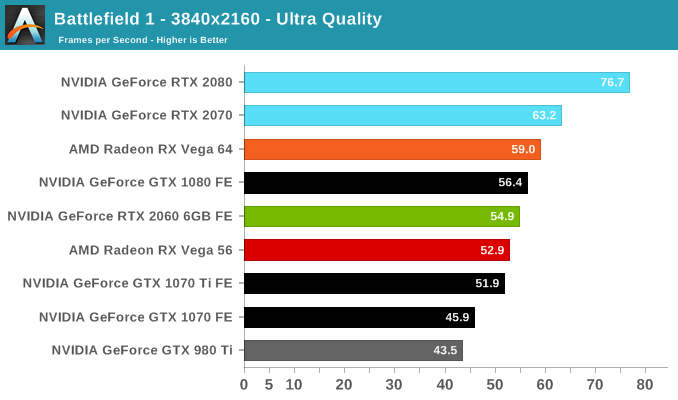

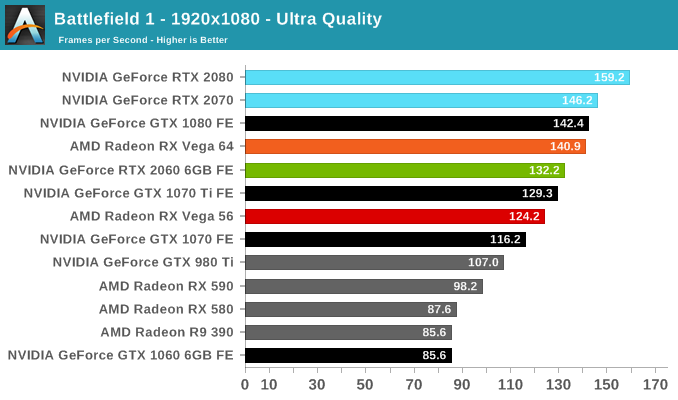
Battlefield 1 has made the rounds for some time, and after the optimizations over the years both manufacturers generally enjoy solid performance across the board. The RTX 2060 (6GB) is no exception and fares well, splitting the difference between the GTX 1070 Ti and GTX 1080. This also means it opens a lead on the RX Vega 56.

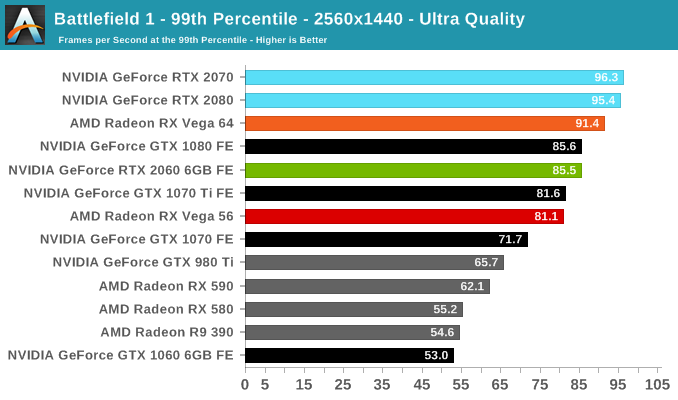
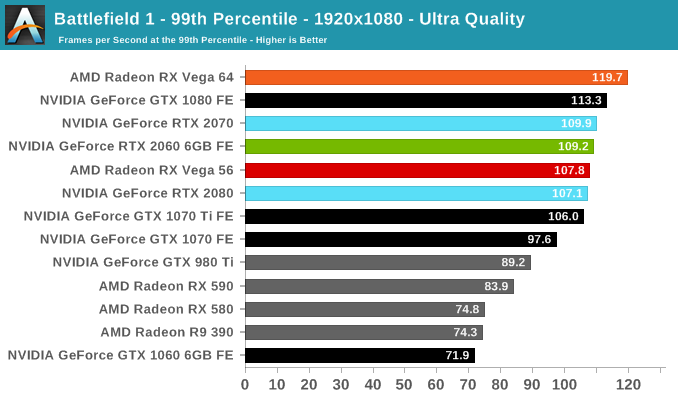


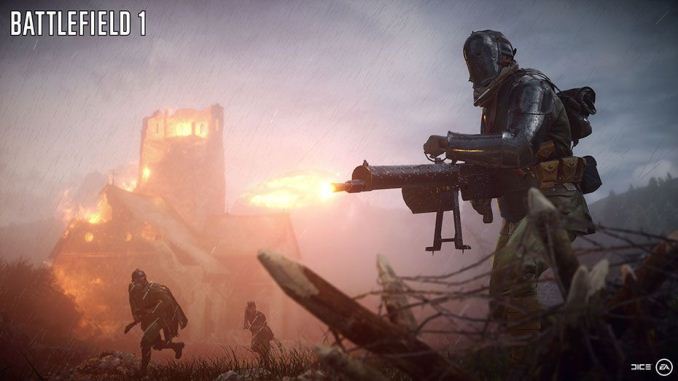








134 Comments
View All Comments
just4U - Wednesday, January 23, 2019 - link
wait late to this and likely no one will read it but shoot you never know. I have Vega cards. I undervolt and overclock. They work great.sing_electric - Monday, January 7, 2019 - link
Here's the thing, though, right now, there ISN'T a card on the market that offers anything like that level of performance for that price, if you can actually buy one for close to MSRP. The RX 590 is almost embarrassing in this test; a recently-launched card (though based on older tech) for $60 less than the 2060 but offering nowhere near the performance. The way I read the chart on performance/prices, there's good value at ~$200 (for a 580 card), then no good values up till you get to the $350 2060 (assuming it's available for close to MSRP). If AMD can offer the Vega 56 for say, $300 or less, it becomes a good value, but today, the best price I can find on one is $370, and that's just not worth it.jrs77 - Monday, January 7, 2019 - link
I don't say, that the 2060 isn't good value, but it simply is priced way too high to be a midrange card, which the xx60-series is supposed to be.Midrange = $1000 gaming-rig and that only leaves some $200-250 for the GPU. And as I wrote, even the 1060 was out of that pricerange for most of the last two years.
sing_electric - Monday, January 7, 2019 - link
I totally get your point - but to some extent, it's semantics. I'd never drop the ~$700 that it costs to get a 2080 today, but given that that card exists and is sold to consumers as a gaming card, it is now the benchmark for "high end." The RTX 2060 is half that price, so I guess is "mid range," even if $350 is more than I'd spend on a GPU.We've seen the same thing with phones - $700 used to be 'premium' but now the premium is more like $1k.
The one upside of all this is that the prices mean that there's likely to be a lot of cards like the 1060/1070/RX 580 in gaming rigs for the next few years, and so game developers will likely bear that in mind when developing titles. (On the other hand, I'm hoping maybe AMD or Intel will release something that hits a much better $/perf ratio in the next 2 years, finally putting pricing pressure on Nvidia at the mid/high end which just doesn't exist at the moment.)
Bluescreendeath - Monday, January 7, 2019 - link
It could be possible that the GTX2060 is not midranged but lower high range card. Most XX60 cards in the past were midranged, but they were not all midranged. Though most past XX60 cards have been midranged and cost around $200-$300, if you go to the GTX200 series, the GTX260's MSRP was $400 and was more of an upper ranged card. The Founder's Edition of the 1060 also launched at $300.dave_the_nerd - Monday, January 7, 2019 - link
Weeeeeeeeeelllll.... before all the mining happened, the 970 was a pretty popular card at $300-$325. (At one point iirc it was the single most popular discrete GPU on Steam's hardware survey.)Vayra - Wednesday, January 9, 2019 - link
Yeah, I think 350 is just about the maximum Nvidia can charge for midrange. The 970 had the bonus of offering 780ti levels of performance very shortly after that card launched. Today, we're looking at almost 3 years for such a jump (1080 > 2060).StrangerGuy - Wednesday, January 9, 2019 - link
I paid an inflated $450 for my launch 1070 2.5 years, and this 2060 is barely faster at $100 less. Godawful value proposition especially when release dates are taken into consideration.ScottSoapbox - Monday, January 7, 2019 - link
I wonder if custom 2060 cards will add 2GB more VRAM and how much that addition will cost.A5 - Monday, January 7, 2019 - link
It's been a *long* time since I've seen a board vendor offer a board with more VRAM than spec'd by the GPU maker. I would be surprised if anyone did it...easier to point people at the 2070.